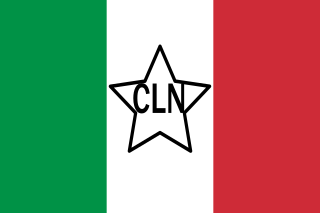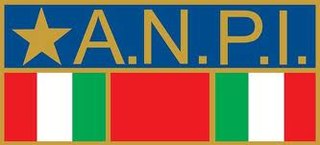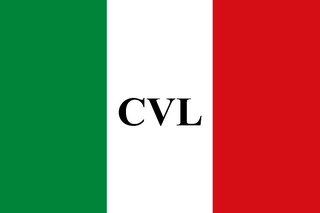A resistance movement is an organized group of people that tries to resist the government or an occupying power, causing disruption and unrest in civil order and stability. Such a movement may seek to achieve its goals through either the use of nonviolent resistance, or the use of force, whether armed or unarmed. In many cases, as for example in the United States during the American Revolution, or in Norway in the Second World War, a resistance movement may employ both violent and non-violent methods, usually operating under different organizations and acting in different phases or geographical areas within a country.
Clerical fascism is an ideology that combines the political and economic doctrines of fascism with clericalism. The term has been used to describe organizations and movements that combine religious elements with fascism, receive support from religious organizations which espouse sympathy for fascism, or fascist regimes in which clergy play a leading role.

The Italian resistance movement is an umbrella term for the Italian resistance groups who fought the occupying forces of Nazi Germany and the fascist collaborationists of the Italian Social Republic during the Second World War in Italy from 1943 to 1945. As a diverse anti-fascist movement and organisation, the Resistenza opposed Nazi Germany, as well as Nazi Germany's Italian puppet state regime, the Italian Social Republic, which the Germans created following the Nazi German invasion and military occupation of Italy by the Wehrmacht and the Waffen-SS from 8 September 1943 until 25 April 1945.
Resistance movements during World War II occurred in every occupied country by a variety of means, ranging from non-cooperation to propaganda, hiding crashed pilots and even to outright warfare and the recapturing of towns. In many countries, resistance movements were sometimes also referred to as The Underground.
Lionello Levi Sandri was an Italian politician and European Commissioner.

Giustizia e Libertà was an Italian anti-fascist resistance movement, active from 1929 to 1945. The movement was cofounded by Carlo Rosselli, Ferruccio Parri, who later became Prime Minister of Italy, and Sandro Pertini, who became President of Italy.

The Italian Civil War was a civil war in the Kingdom of Italy fought during the Italian campaign of World War II between Italian fascists and Italian partisans and, to a lesser extent, the Italian Co-belligerent Army.

Maurilio Fossati, O.SS.G.C.N., was an Italian Cardinal of the Roman Catholic Church who served as Archbishop of Turin from 1930 until his death, and was elevated to the cardinalate in 1933.

The National Liberation Committee was a political umbrella organization and the main representative of the Italian resistance movement fighting against Nazi Germany's forces during the German occupation of Italy in the aftermath of the armistice of Cassibile, while simultaneously fighting against Italian fascists during the Italian Civil War. It coordinated and directed the Italian resistance and was subdivided into the Central Committee for National Liberation (CCLN), which was based in Rome, and the later National Liberation Committee for Northern Italy (CLNAI), which was based in Milan. The CNL was a multi-party entity, whose members were united by their anti-fascism.
The Porzûs massacre was an intra-partisan massacre of the Italian resistance during late World War II, on 7 February 1945. It saw the killings of 17 partisans belonging to the Brigate Osoppo, a strongly Catholic formation, by communist partisans of the Gruppi di Azione Patriottica. Four members of Brigate Osoppo were killed when a group of them was ambushed, while the survivors were taken prisoner and summarily executed in the following days. The event is still the object of study and controversy in Italy.
William Oliver Churchill, (1914–1997) was a Special Operations Executive (SOE) officer during the Second World War.

Associazione Nazionale Partigiani d'Italia is an association founded by partisans and participants of the Italian Resistance against the Italian fascist regime and the subsequent Nazi occupation during World War II. ANPI was founded in Rome in 1944, as the war continued in northern Italy. It was constituted as a charitable foundation on 5 April 1945. It persists due to the activity of its anti-fascist members.

The Croatian Partisans, officially the National Liberation Movement in Croatia, were part of the anti-fascist National Liberational Movement in the Axis-occupied Yugoslavia which was the most effective anti-Nazi resistance movement led by Yugoslav revolutionary communists during the Second World War. NOP was under the leadership of the League of Communists of Yugoslavia (KPJ) and supported by many others, with Croatian Peasant Party members contributing to it significantly. NOP units were able to temporarily or permanently liberate large parts of Croatia from occupying forces. Based on the NOP, the Federal Republic of Croatia, which was referred to by Winston Churchill as "the Croatian miracle" was founded as a constituent of the Democratic Federal Yugoslavia.
The Italian partisan brigades were armed formations involved in the Italian resistance during the World War II.

The Brigate Garibaldi or Garibaldi Brigades were partisan units aligned with the Italian Communist Party active in the armed resistance against both German and Italian fascist forces during World War II.
The Brigate Osoppo-Friuli or Osoppo-Friuli Brigades were autonomous partisan formations founded in the headquarter of the Archbishop Seminary of Udine on 24 December 1943 by partisan volunteers of mixed ideologies, already active in Carnia and Friuli before the Badoglio Proclamation of 8 September. The partisans in this brigade adhered to various and often conflicting ideologies, including both secularism and Catholicism, as well as socialism and liberalism.

Pompeo Colajanni was an Italian politician and Resistance leader during World War II. After the war he held various political positions, including that of Undersecretary for Defense in the Parri and De Gasperi I cabinets and of member of the Italian Chamber of Deputies in 1975–1976.

The Corpo Volontari della Libertà was the unified command structure of the Italian Resistance during the Second World War, recognized both by the Allies and the "southern" Italian governments.
The anarchist brigades of the Italian Resistance were active during the Second World War, especially in central and northern Italy.
The Lucetti Battalion was an anarchist partisan brigade that operated in the surroundings of Carrara.









